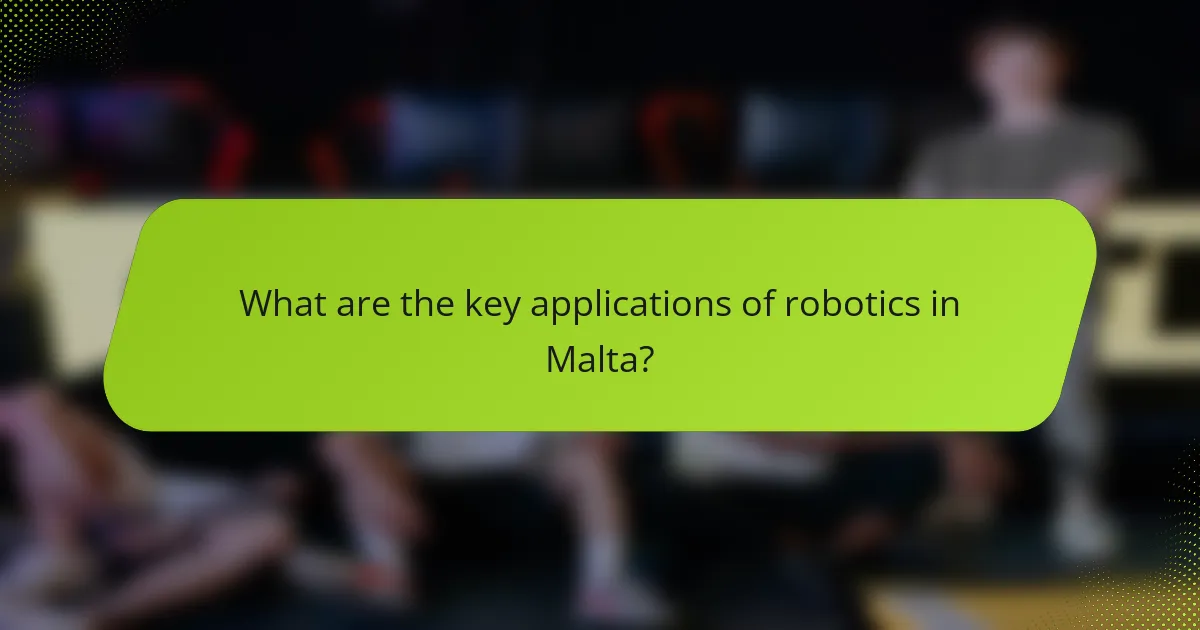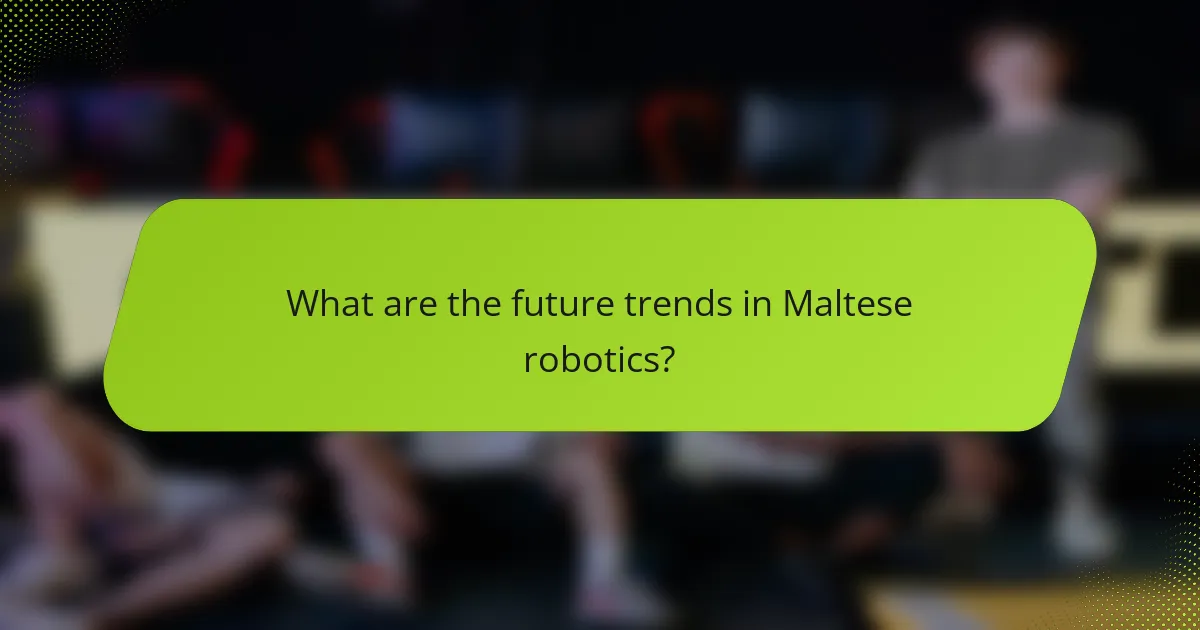
What is the Evolution of Maltese Robotics?
The evolution of Maltese robotics has progressed significantly since the early 2000s. Initial developments focused on academic research and collaboration with international institutions. The University of Malta has played a crucial role in fostering robotics education and innovation. In recent years, local startups have emerged, creating robots for various applications. These include healthcare, agriculture, and industrial automation. Government initiatives have supported the growth of the robotics sector through funding and infrastructure development. Malta’s strategic location has also made it an attractive hub for robotics companies. As a result, the robotics landscape in Malta continues to evolve, driven by technological advancements and market demands.
How has Maltese robotics developed over the years?
Maltese robotics has progressed significantly over the years. Initially, the field was limited to academic research and small-scale projects. In the early 2000s, universities began to establish dedicated robotics programs. This led to increased collaboration between academia and industry. By 2010, local startups began to emerge, focusing on innovative robotic solutions. Notable advancements include developments in automation for manufacturing and healthcare. The government has also supported robotics through funding and initiatives. Recent years have seen a rise in robotics competitions and community engagement. Overall, Maltese robotics has evolved from basic research to a dynamic sector with diverse applications.
What were the key milestones in the evolution of Maltese robotics?
Maltese robotics has evolved through several key milestones. In 1999, the University of Malta established the Institute of Robotics and Industrial Informatics. This initiative marked the beginning of formal robotics education and research in Malta. In 2005, the first Maltese robot, a small autonomous vehicle, was developed for environmental monitoring. In 2010, Malta hosted its first international robotics competition, fostering local interest and innovation. By 2015, the introduction of robotics in educational curricula further enhanced public engagement. In 2018, Maltese researchers collaborated on projects with international institutions, expanding their technological capabilities. By 2021, Malta’s robotics sector had grown significantly, focusing on applications in healthcare and agriculture. These milestones highlight the progressive development of robotics in Malta, showcasing its commitment to innovation and technology.
How do historical events influence current robotics in Malta?
Historical events significantly shape current robotics in Malta. The strategic location of Malta has historically attracted various technological advancements. For instance, the presence of military and naval bases led to early developments in automation and robotics for defense purposes. In the late 20th century, Malta’s entry into the European Union facilitated funding and collaboration in technology sectors. This increased investment has spurred innovation in robotics, particularly in healthcare and manufacturing. Educational initiatives, influenced by historical shifts in policy, have also fostered a skilled workforce in robotics. Current robotics projects often reflect these historical influences, focusing on automation to enhance productivity in various industries. Thus, the legacy of Malta’s historical events continues to drive its robotics landscape today.
What are the primary technologies driving Maltese robotics?
The primary technologies driving Maltese robotics include artificial intelligence, machine learning, and sensor technology. Artificial intelligence enables robots to perform complex tasks autonomously. Machine learning allows robots to improve their performance through data analysis. Sensor technology enhances robots’ ability to perceive their environment. These technologies are crucial for applications in sectors like healthcare, agriculture, and manufacturing in Malta. The integration of these technologies has led to innovative robotic solutions tailored to local needs. For instance, AI-driven robots are being developed for elderly care in Maltese communities.
Which robotics technologies are most prevalent in Malta?
The most prevalent robotics technologies in Malta include industrial automation, service robots, and drone technology. Industrial automation is widely used in manufacturing sectors, enhancing efficiency and productivity. Service robots are increasingly utilized in healthcare and hospitality, providing assistance and improving service quality. Drone technology has gained traction for applications in surveillance, agriculture, and delivery services. The presence of educational institutions and research centers supports the growth of these technologies. Malta’s strategic location also fosters innovation and investment in robotics.
How do these technologies compare to global standards?
Maltese robotics technologies generally align with global standards in automation and innovation. The local industry has adopted advanced robotics techniques comparable to those used internationally. For instance, Malta’s robotics initiatives leverage AI and machine learning, similar to global leaders like Japan and the USA. Additionally, the integration of robotics in sectors such as healthcare and manufacturing mirrors practices in countries known for technological advancements. The European Union’s regulations also influence Maltese standards, ensuring compliance with global safety and efficiency benchmarks. Overall, Maltese robotics reflects a commitment to maintaining competitive global standards in technology and application.

What are the key applications of robotics in Malta?
Key applications of robotics in Malta include manufacturing, healthcare, agriculture, and tourism. In manufacturing, robotics enhances production efficiency and quality control. In healthcare, robotic systems assist in surgeries and patient care, improving outcomes. Agriculture utilizes robotics for precision farming, increasing crop yields and reducing labor costs. The tourism sector employs robots for customer service and information dissemination, enhancing visitor experiences. These applications are supported by Malta’s investment in technology and innovation, fostering a growing robotics industry.
In which industries is robotics most commonly used in Malta?
Robotics is most commonly used in the manufacturing, healthcare, and agriculture industries in Malta. In manufacturing, robotics enhances efficiency and precision in production processes. The healthcare sector utilizes robotics for surgical assistance and rehabilitation. In agriculture, robotic systems aid in tasks such as planting, harvesting, and monitoring crops. These applications reflect Malta’s commitment to integrating advanced technologies across key sectors. The growing adoption of robotics aligns with global trends towards automation and innovation.
What role does robotics play in manufacturing in Malta?
Robotics plays a significant role in manufacturing in Malta by enhancing efficiency and precision. The integration of robotic systems in production lines has streamlined processes. These systems reduce human error and increase output rates. In Malta, industries such as electronics and pharmaceuticals utilize robotics extensively. According to a report by the Malta Chamber of Commerce, robotic automation has improved productivity by up to 30%. Furthermore, robotics contributes to labor cost savings and improved safety in manufacturing environments. The Maltese government supports this trend through initiatives promoting technology adoption. This focus on robotics positions Malta as a competitive player in the global manufacturing landscape.
How is robotics transforming healthcare services in Malta?
Robotics is significantly transforming healthcare services in Malta by enhancing surgical precision and improving patient care. Advanced robotic systems assist surgeons in performing minimally invasive procedures. These systems reduce recovery times and minimize complications. Additionally, robotic technology is utilized in rehabilitation, helping patients regain mobility. Robots are also being deployed for medication dispensing in hospitals, ensuring accuracy and efficiency. Telepresence robots enable remote consultations, increasing access to healthcare specialists. The integration of robotics in healthcare has led to improved operational efficiency in Maltese hospitals. Overall, these advancements reflect a growing trend towards automation in the Maltese healthcare sector.
What are the societal impacts of robotics in Malta?
Robotics in Malta significantly impacts various societal aspects. It enhances productivity across industries, particularly in manufacturing and healthcare. Automation leads to increased efficiency, reducing operational costs for businesses. The introduction of robotics creates new job opportunities in tech and engineering fields. Educational institutions are adapting curricula to include robotics, fostering a skilled workforce. Additionally, robotics improves quality of life through assistive technologies for the elderly and disabled. Research indicates that the integration of robotics can boost Malta’s economy by 1.5% annually. Overall, robotics is transforming Malta’s economic landscape and societal structure positively.
How do robotics initiatives affect employment in Malta?
Robotics initiatives in Malta significantly impact employment by creating new job opportunities while also displacing some traditional roles. The introduction of robotics technology leads to increased efficiency in various sectors, including manufacturing and healthcare. This efficiency can result in job creation in high-skilled areas such as robotics engineering and maintenance. According to the Malta Chamber of Commerce, the robotics sector is expected to grow, potentially adding thousands of jobs by 2025. However, automation may replace lower-skilled positions, necessitating workforce reskilling. The government of Malta has recognized these trends and is investing in education and training programs to prepare workers for the changing job landscape. This dual effect of job creation and displacement highlights the need for strategic workforce development in response to robotics initiatives.
What ethical considerations arise from the use of robotics in Maltese society?
Ethical considerations from the use of robotics in Maltese society include job displacement and privacy concerns. The introduction of robotics can lead to reduced job opportunities in certain sectors. Studies indicate that automation may replace roles in manufacturing and service industries. Additionally, the deployment of surveillance robots raises questions about individual privacy rights. There is a risk of data misuse and unauthorized surveillance. Ethical frameworks must address these issues to ensure responsible robotics integration. Public discourse in Malta emphasizes the need for regulations to protect citizens. Balancing innovation with ethical standards is crucial for societal acceptance.

What are the future trends in Maltese robotics?
Future trends in Maltese robotics include advancements in automation and artificial intelligence. These technologies are increasingly being integrated into various sectors. The healthcare sector is expected to see more robotic assistance in surgeries and patient care. Agriculture will likely adopt robotic systems for precision farming and monitoring crops. The manufacturing industry is moving towards smart factories with interconnected robotic systems. Research and development in educational robotics are also on the rise. Collaborations between universities and tech companies are promoting innovation. Malta’s government is actively supporting robotics through funding and initiatives. These trends reflect a growing commitment to enhancing efficiency and productivity across industries.
What innovations are on the horizon for robotics in Malta?
Innovations on the horizon for robotics in Malta include advancements in automation and artificial intelligence. Research initiatives are focusing on integrating AI with robotics for improved decision-making. Local universities are collaborating with industries to develop robotic solutions for healthcare and agriculture. The government is investing in technology parks to foster robotics startups. These efforts aim to enhance efficiency in various sectors. Statistics show that the robotics market in Malta is expected to grow significantly in the next five years. This growth is driven by increased demand for automation and smart technologies.
How might advancements in AI influence Maltese robotics?
Advancements in AI will significantly enhance Maltese robotics by improving automation and decision-making capabilities. AI integration allows robots to process data more efficiently. This results in better navigation and interaction in various environments. Enhanced machine learning algorithms enable robots to learn from experiences. Consequently, this leads to improved performance over time. AI-driven robotics can also facilitate complex tasks in healthcare and manufacturing sectors. For instance, AI can optimize robotic surgery or automate assembly lines. The Maltese robotics industry can leverage these advancements to stay competitive in a global market.
What emerging technologies are expected to shape the future of robotics in Malta?
Artificial intelligence, machine learning, and advanced sensors are emerging technologies expected to shape the future of robotics in Malta. These technologies enhance automation and improve decision-making in robotic systems. AI enables robots to learn from data, adapting to new tasks and environments. Machine learning algorithms allow for predictive maintenance, reducing downtime in industries. Advanced sensors improve navigation and interaction with surroundings. The integration of these technologies is evident in local startups and research initiatives. Malta’s strategic investments in tech infrastructure support this growth. The government promotes innovation through funding and collaborations with educational institutions. These efforts position Malta as a hub for robotics development in the Mediterranean region.
What challenges does the Maltese robotics industry face moving forward?
The Maltese robotics industry faces several challenges moving forward. Limited funding and investment hinder research and development. A shortage of skilled professionals affects workforce capacity. Regulatory hurdles can delay innovation and deployment. Collaboration between academia and industry is often insufficient. Additionally, market competition from larger countries poses a significant threat. These factors collectively impact the growth and sustainability of the industry.
How can the industry overcome barriers to innovation?
The industry can overcome barriers to innovation by fostering a culture of collaboration. Collaborative efforts between businesses, research institutions, and government can stimulate new ideas. Investment in research and development is crucial for driving technological advancements. Access to funding and resources supports innovative projects. Additionally, implementing flexible regulatory frameworks encourages experimentation. Training and education programs can equip the workforce with necessary skills. Successful examples include partnerships in robotics that have led to breakthroughs in automation. These strategies collectively enhance the innovation landscape within the industry.
What role does government policy play in the future of robotics in Malta?
Government policy significantly influences the future of robotics in Malta. It shapes funding opportunities and research initiatives. Policies can encourage innovation through grants and subsidies. Regulatory frameworks determine the operational landscape for robotics. The Maltese government has established the Malta Digital Innovation Authority to support technology sectors. This authority aims to foster collaboration between industry and academia. Government policies also focus on workforce development in robotics and AI. By investing in education and training, the government prepares talent for future demands.
What best practices can be adopted for successful robotics implementation in Malta?
Successful robotics implementation in Malta requires strategic planning and collaboration. Engaging stakeholders early enhances project alignment with local needs. Training programs for workforce development ensure that employees are skilled in robotics technologies. Establishing partnerships between academia and industry fosters innovation and research. Conducting pilot projects allows for testing and refining robotic solutions in real-world environments. Adopting regulatory frameworks that support robotics can facilitate smoother implementation. Continuous evaluation and feedback mechanisms help improve robotic systems over time. These practices are essential for maximizing the benefits of robotics in Malta’s evolving technological landscape.
The main entity of this article is Maltese robotics, which has evolved significantly since the early 2000s, driven by academic research, local startups, and government support. Key technologies such as artificial intelligence and automation are transforming various sectors, including manufacturing, healthcare, and agriculture. The article highlights important milestones in the development of robotics in Malta, examines the societal impacts and ethical considerations, and discusses future trends and challenges facing the industry. Overall, it provides a comprehensive overview of the current state and future potential of robotics in Malta.
